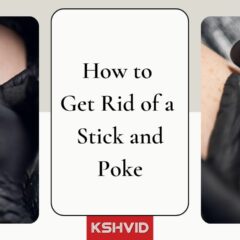Dreadlocks, or locs, are a versatile hairstyle; however, maintaining healthy locs requires dedication and proper care. Facing issues with your locs? Learn to identify signs of unhealthy locs and discover effective solutions to restore their natural health and beauty.
Read: Brotherlocks: A Detailed Guide for Men’s Hairstyle 2023
Difference Between Healthy and Unhealthy Locs
Healthy locs refer to well-maintained and properly cared-for dreadlocks. They have a neat and well-defined appearance and experience minimal breakage and thinning.
On the other hand, unhealthy locs are those that have not been adequately maintained or are experiencing issues that affect their overall health. Moreover, they have a curly look and are prone to breakage and thinning due to improper maintenance techniques.
Signs of Healthy Locs
- Healthy locs are clean and have no unpleasant odors.
- They are adequately moisturized and have a natural sheen.
- The roots of healthy loc are tightly formed and firmly attached to the scalp.
- Healthy locs are resilient and show minimal signs of breakage.
- They possess a consistent size and shape throughout the hair.
- Healthy locs show consistent growth over time.
Read: What is Soft Locs? 3 Steps To Take Down Soft Locs
Common Signs of Unhealthy Locs
- Persistent scalp irritation, itching, or dryness can be an early sign of unhealthy locs. It may indicate an imbalance in moisture levels or an accumulation of product residue.
- If your locs appear weak, brittle, or break easily, it could be a sign of damage or inadequate care.
- Excessive hair loss from your locs is a famous sign of an underlying issue.
- A foul smell from your locs and a sticky or greasy residue can signify product build-up or improper cleansing.
- Accumulated residue can make a growing place for bacteria and fungi, resulting in scalp infections.
- If your locs feel excessively heavy, appear to be stretching, or have lost their initial shape and structure, they may indicate that they need to be adequately supported or dried or have accumulated excessive moisture.
Read: 5 Steps for Bleaching Honey Blonde Locs – Follow Tips
Solutions to Repair Unhealthy Locs
To repair unhealthy or damaged locs, regularly moisturize your scalp and locs with natural oils or a water-based moisturizer.
- Avoid excessive manipulation, rough handling, or pulling your locs.
- Deep condition your locs regularly to restore moisture and strengthen the hair.
- Evaluate your diet and ensure you consume a balanced mix of vitamins, minerals, and proteins for healthy hair growth.
- Avoid hairstyles that create excessive tension or pull on the locs.
- Wash your locs regularly using a residue-free or gentle clarifying shampoo to eliminate any build-up.
In addition, avoid oversaturation of your locs during washing and ensure they are scorched after cleansing. Consider palm rolling or interlocking methods to help maintain the shape and structure of your locs.
Read: How to Make Curly Dreads in 4 Easy Steps?
Is there any Benefit of avoiding retwisting Locs?
Yes, there are benefits of avoiding retwisting of locs. However, it relies on the type of hair an individual has and personal choices.
The following are a few potential advantages:
- Over-retwisting can create strain on hair shafts, leading to breakage.
- By avoiding frequent retwisting, the hair can naturally expand and lock, resulting in fuller and thicker locs.
- Retwisting can sometimes cause scalp irritation or tension headaches.
- Avoiding retwisting can give you a natural aesthetic look
- Retwisting can be a time-consuming process. By avoiding it, individuals can save time and potentially reduce expenses associated with salon visits or maintenance products.
Read: 10 Light Skin with Dreads Hairstyle Ideas
Steps to Restore and Strengthen Thinning Locs at the Root
If your locks are thinning at the root, then it’s essential to consider the issue on time to avoid further damage.
- First, To repair thin locs, assess your current hair care practices and products to ensure that your locs are not causing or contributing to the thinning.
- Avoid harsh chemicals, excessive manipulation, and tight hairstyles that stress the roots.
- Wash your locs regularly to maintain cleanliness. Considering this, be gentle during the process.
- Moreover, use a sulfate-free shampoo formulated explicitly for locs or natural hair.
- Furthermore, avoid scrubbing or rubbing vigorously at the roots, as this can weaken them further.
- Try to massage your scalp daily, which will help enhance blood circulation and revive hair growth.
- Also, moisturize your scalp using natural oils or a light moisturizer formulated for locs.
- More importantly, take a satin or silk scarf, bonnet, or pillowcase to cover your locs during sleep.
Pro Tip:
If you’re experiencing significant thinning or hair loss, it’s advisable to consult a professional hairstylist or a trichologist (hair and scalp specialist).
Read: What’s the difference between Microlocs vs Sisterlocks
How to determine if your dreads are growing?
To determine if your dreadlocks are growing, look for a few indicators.
- Like, firstly, measure the length of your dreads periodically.
- Keep monitoring changes with time to observe if they are getting longer.
- Pay attention to the roots of your dreads.
You will notice new hair emerging at the roots as your hair grows. As your hair grows, your dreads may become tighter and denser. Therefore, if you regularly retwist or maintain your dreads, eventually, you will notice growth during these sessions.
- Take pictures of your dreads periodically, with consistent lighting and angles.
Lastly, by comparing these photos over time, you can observe any changes in length or overall appearance, which will indicate growth.
Read: Thick Dreadlocks vs Wicks Dreads | Which One is Best?








